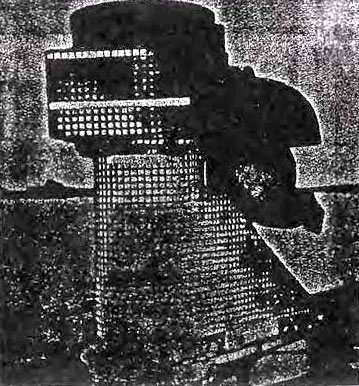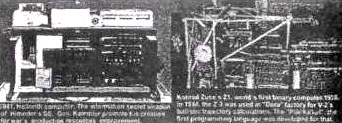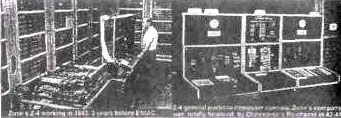|
Chapter 12 THE ALCHEMY OF ATLANTIS: AN INVENTORY OF NAZI SECRET WEAPONS AND THEIR HISTORICAL PROBLEMATIC
1 Renato Vesco and David Hatcher Childress, Man-Made UFOs 1944 1994: 50 Years of Suppression, p. 147. There have been a host of books about Nazi secret weapons, detailing what is an incredible inventory of prototypical and futuristic weapons, from heat-seeking, wire-guided, radio guided, and even television-guided missiles, to tanks so gigantic that they are little more than impractical mobile pillboxes, to claims of the genuinely fantastic: flying discoid aircraft, or flying saucers, to fuel-air bombs, "death rays", particle beams, electromagnetic pulse weapons, "wind" cannon, and so on. And beyond these, there were even more incredible long-range paper studies of nuclear powered aircraft and "space shuttles", gigantic solar mirrors in orbit to turn enemy cities and regions to toast, and a host of other paper projects almost too incredible to imagine. Usually dismissed derisively, these claims persisted in the literature, long after Adolf Hitler himself personally mentioned them, in what is usually seen as the demented ravings of a known madman:
Hitler's alleged claims here could easily be dismissed, as well as those of the postwar neo-Nazi sympathizers who first broke the story of Nazi flying saucers, as the farthest thing from "the purest truth." Dealing with a known sociopath and genocidal maniac such as Hitler and his followers, it became easy to dismiss such claims especially when there was no corroborating evidence forthcoming. Then Renato Vesco's Intercept UFO was published in the 1960 later republished, and then later republished again with additional material by David Hatcher Childress under the title Man Made UFOs 1944-1994: Fifty Years of Suppression. Vesco, who unlike the neo-Nazi sympathizers who emerged after the war to first tell the story in the West German press provided a host of specifics, such as the names, types of weapons and laboratories and companies conducting the research on these advanced technologies. But again, as Nick Cook was to discover, the trail seemed to lead back to the same few sources, and it became a story impossible to corroborate.3 Vesco had mentioned the British Intelligence Objectives Sub-Committee (BIOS) reports as substantiation for his claims, but those were, at that time, mostly inaccessible, and in addition, "researchers had been through all the available... BIOS files with a fine-tooth comb and had found nothing..."4 2. Mayer and Mehner, Das Geheimnis, p. 97, the quotation was overheard by Italian officer Luigi Romersa, q.v. chapter 5, p. 97 of this book. 3. Nick Cook, The Hunt for Zero Point, p. 53. 4. Ibid, p. 57. Vesco couched his account of alleged Nazi "Fireballs" (the so-called Foo Fighters seen at the end of the war), within a tapestry of references to these other advanced missile projects undertaken by the Third Reich. But as researcher Kevin McClure put the case, Vesco's "technical" descriptions of the alleged Nazi devices behind the Foo Fighters sightings were based on "pseudo-technical descriptions" that originated "absolutely and only with Vesco."5 Add to this Vesco's claims for " fuel-air bombs" and the story - Vesco's detailed references to scientists, companies and laboratories notwithstanding - became all too easy to dismiss once again. But then came the German reunification and the resulting declassification of documents by the American, British, and German governments. The truth is not merely incredible, but staggering, and it poses host of historical problematics, as we shall see.
A Combined Intelligence Objectives Sub-Committee (CIOS) report, number XXXII-125, running to more than one hundred and fifty pages, details not only "an experimental model of an additional thrust unit which was to be fastened to either the A4(V-2) or the A- 9 to give an additional range,"6 but also various "America Raket" projects for a guided missile with a range of 3,500 miles.7 These latter rockets, the report notes, with less than complete reassurance, "probably never progressed beyond the drawing board stage."8 But additionally, there was a V-3 weapon, "a larger version of the V1 with an incendiary warhead instead of the (high explosive) normally used. Very little information is available concerning V3 control systems."9 What, indeed, was this "incendiary warhead"? A thermite bomb? A fuel-air bomb? An actual atom bomb? The report is unclear. 5. Keven McClure, The Nazi UFO Mythos, Core 2: "Renato Vesco, Feuerball and Kugelblitz, p. 5, internet published book, www.magonia.demon.co.uk/abwatch/naziufo/naziufo3.html. 6. "German Guided Missile Research, Combined Intelligence
ObjectivesSub-Committee, G-2 Division, SHAEF (Rear), APO 413, XXXII-125,
p. 5. As if this were not enough, a lengthy section of the report concerns a whole range of guided missiles being developed under the direction of Dr. Wagner for the Henschel firm. These included the HS-293-B, a rocket power glider with a wire guidance system,10 the HS-294-A rocket powered glider "with torpedo" that included a "special device for blowing off fuselage rear section and wings as soon as body touches water surface, fuselage front section then cruising as torpedo under water," a small quantity of which were built for experimentation between 1941 and 1943!11 A lengthy section of the report, from page 139 to almost the end of the report, concerned the development of miniaturized television camera guidance systems for various missiles, including the well-known anti-aircraft rocket, the "WasserfaU" (Waterfall),12 Many of these tests failed, but by the war's end, a successful test of the television-guided "Tonne" missile was conducted by German scientists for the Allies in Berlin, with the target being a photograph of a little girl's face. The test was successful, much to the impressed, and doubtless shocked, Allied observers.13 To this astounding inventory, one may add radio-controlled surface to air missiles - one of which sank the Italian battleship Roma on its way to surrender to the Allies - infrared heat seeking air-to-air and surface to air missiles, wire guided missiles and torpedoes, biological and chemical warheads for the V-l and V-2, and possible fuel-air and atomic warheads as well.14 In addition, the Heinkel and Messerschmitt companies were undertaking modifications of their He-177 and Me 264 heavy bombers to carry atom bombs. Where were these modifications being made? In Prague.15 10.Ibid., p. 8. 11.Ibid., p. 9. 12.Ibid., pp. 139-150. 13.William Uricchio, "Envisioning the Audience: Perceptions of Early German Television's Audiences, 1935-1944, p. 1., http://www.let.uu.nl/~william.uricchio/personal/SWEDEN1.html. 14 .Q.v. Friedrich Georg, Hitlers Siegeswaffen, Band 1, pp. 128-143 15. Ibid.
B. Prototypical Stealth (Radar Absorbent) Materials But Hitler's boast overheard by Luigi Romersa included more than just a prototypes for the "smart" weapons that would become such staples of the American military for decades to come. It also included a claim to possess invisible aircraft and submarines. Surely this, at least, was fantasy? Not so. There exists a British Intelligence Objectives Sub-Committee (BIOS) report entitled "Production and Further Investigation of Wesch Anti-Radar Material, CIOS Black List Item 1 RADAR, BIOS Target No. 1/549," whose significance is rather obvious from its title. The objective of this team was to acquire some 500 feet of this material for secret testing by the British Admiralty.16 The report details the production of various RAM materials (Radar Absorbent Material) by the Germans,17 via techniques that involved shredding and heating rubber, and combining zinc oxide, finely ground iron powder (the powder was ground into micro-spheres), which was all then pressed into sheets, and then transferred to press moulds, trimmed and heated under small pressure. This material was actually used on the hulls of some late Type XXI U-Boats, as well as on U-boat schnorkel devices, to scatter Allied radar to return distorted or indeed, no radar signals.18 16. "Production and farther Investigation of Wesch Anti-Radar Material," British Intelligence Objectives Sub-Committee 1/549, Report 132, p. 4. 17.Ibid., pp. 5-6. 18. Ibid., pp. 5-7.
German Schnorkel Coated with Early "Stealth" Material Yet another type of RAM technology was being studied by the Germans for its effects on electromagnetic wave propagation. As this is an important point that we will return to later, the report on this material is cited in full here:
I.G. Farben, and missing papers, once again. And submarine stealth was not the only thing the Nazis were after:
As we shall see, this research may have paid unexpected dividends to the German secret weapons research project. In any case, the existence of actual "protostealth" schnorkel devices on late war German U-boats attests to the success of some of these experiments. This report also corroborates yet another allegation, often derisorily dismissed by mainstream researchers, that in May of 1945, a small flotilla of the new Type XXI U-boats, with their revolutionary hydrogen peroxide underwater "turbine" propulsion allowing extraordinary undersea cruising speeds, met, and annihilated, a flotilla of British destroyers.21 19. Ibid., p. 57. 20. Ibid., p. 63. 21. Q.v. Henry Stevens, Tha Last Battalion (German Research Project). The allegations included the German use of new types of wire-guided, and magnetic proximity torpedoes.22 At least one corroboration of this strange encounter occurs in the BIOS report:
22. Q.v. Henry Stevens, The Last Battalion (German Research Project). 23. "Production and further Investigation of Wesch Anti-Radar Material," British Intelligence Objectives Sub-Committee 1/549, Report 132, p. 63, emphasis added.
The Allies, as is known, perfected early digital computing machines during the war, which machines were instrumental in breaking the "unbreakable" German Enigma machine's ciphers, but also of incalculable value in assisting the Manhattan Project engineers with difficult calculations needed for the atom bomb. In some rarely encountered but sophisticated versions of the Allied Legend, this constitutes another reason for the German failure to develop truly long range rockets and, of course, the atom bomb. But here too, the declassified reality is quite at odds with the postwar spin. A computing machine was used at Gottingen for researches in airplane stability and ballistics. Machine could solve equations mentioned in two or three minutes with errors less than 3%. Only one such machine has been made. It uses ordinary vacuum tubes, a multiplying principle and two cathode ray rubes, one of which has a spiral scan. One tube draws the curve which is the solution and the other indicates the complex roots of the solution.24 24. Ibid. The Gottingen computer, however, appears not to have been the only computer designed and built in the Third Reich. Indeed, since the reunification, reports and actual photographs have surfaced of an enormous, "Eniac" sized computer built by none other than the Deutsche Reichspost.25 The question is, why would the postal service need such an enormous, and expensive, computer? One reason has already been encountered in part one: such a computer would have been invaluable to the research that Baron Manfred von Ardenne and Dr. Fritz Houtermans were conducting for the Reichspost on the atom bomb, and for running the difficult calculations of neutron free path and cross sections that required. 25. Edgar Mayer and Thomas Mehner, p. 188 The Reichspost's Computer
As we have seen, before the curtain of silence and spin came down after the war, a number of small articles appeared in the Allied press about the actual state of German atom bomb research. One of these was an article that appeared in the Evening Standard on August 7, 1945, one day after the Little Boy atom bomb was dropped on Hiroshima. It is worth citing this article in full:
There are a number of disquieting things about this article. First, one gains the impression from the report that the "laboratory" was not even known to the Allies until the factory was occupied. Second, there is already evidence of a "spin" in the report, as the German program is understood to have been underway for only a few "months." But the final and most unusual thing is that its blast effects, some 6 miles radius, or 12 miles in diameter, is far beyond the blast damage radius of even a large atom bomb, much less a fuel air bomb. The only known weapon with this extraordinarily sized blast radius is a fully-fledged hydrogen bomb. 26 Mayer and Mehner, Hitler und die ,,Bombe", p. 51, emphasis added. We have seen in part one that Professor Lachner of Vienna maintained that the German atom bombs were deliberately intended by the Nazis to be used as the detonators for hydrogen bombs. But was there sufficient basic theory for the Germans to have thought of the hydrogen bomb at that early stage?27 27.It should be recalled that Dr. Edward Teller actually first thought of, and proposed to the Allies, the hydrogen bomb in 1944.
31 British Intelligence Objectives Sub-Committee, "Information Obtained from Targets of Opportunity in the Sonthofen Area," BIOS Target numbers C 28/8.211, C 25/549, C 6/137, C 30/ 338, C 4/268, C 22/2182, C 21/601., pp., 4
E. The Historical Problematic: German possession of even a prototype fuel-air bomb during World War Two causes a number of historical problems, and it is worth considering them and their implications.
In other words, the Kammlerstab's mission brief was to think "outside the box" entirely, even if that meant outside the box of Nazi party ideology, or, when it suited it, inside it. The basis was the will to power, by whatever means possible. 3. Whose Military-Industrial Complex? All these considerations raise a final problematic, and one so obvious that I hesitate mentioning it, since others have before, only to be dismissed or not taken seriously. President Eisenhower, as he was leaving office, gave his celebrated warning to the American people about the spiritual and cultural dangers of "the military industrial complex." With the influx of Nazi "Paperclip" scientists, many if not most of whom - including Dornberger, Oberth, and Von Braun - were members of Kammler's "think tank", this warning by someone in the know must surely be interpreted differently than current standard explanations. Having fought the world's first "military-industrial complex" and doubtless seen at least some of its extraordinary inventory of weapons and theoretical papers, President Eisenhower is surely raising another ominous, though overlooked, specter: Just whose military-industrial complex is he really warning about? What possible spiritual and cultural dangers were there to the American people from good old American companies like Boeing, DuPont, Lockheed, Hughes, and so on, unless, in importing ex-Nazi scientists and their unusual methods and insights and experimental results (often achieved at the cost of enormous human suffering), we inadvertently imported an underlying ideology at variance with traditional morality.
|


